Prior to the European invasion, the people of the Northwest Coast lived in large, multi-family houses built with planks on a post and beam frame which were usually arranged in a single row facing the water.
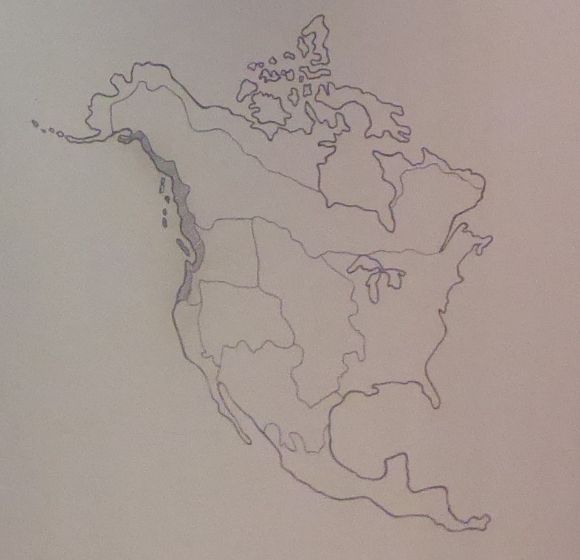 The shaded area on the map shown above shows the Northwest Coast culture area. This map is on display in the Maryhill Museum of Art near Goldendale, Washington.
The shaded area on the map shown above shows the Northwest Coast culture area. This map is on display in the Maryhill Museum of Art near Goldendale, Washington.
The Northwest Coast culture area stretches along the Pacific coast between the Cascade Mountains and the ocean. It extends north of California to Alaska. This is an area which is the home to many Indian nations who traditionally based their economy on the use of sea coast and river ecological resources. The Northwest Coast culture area stretches from the Tlingit homelands in Alaska to the Tolowa homelands in northern California.
Among most of the Northwest Coast tribes, a house was more than a structure: it was a living entity. Thus, the ridgepole for the house was the backbone and the rafters were the ribs and the boards covering the outside were the skin.
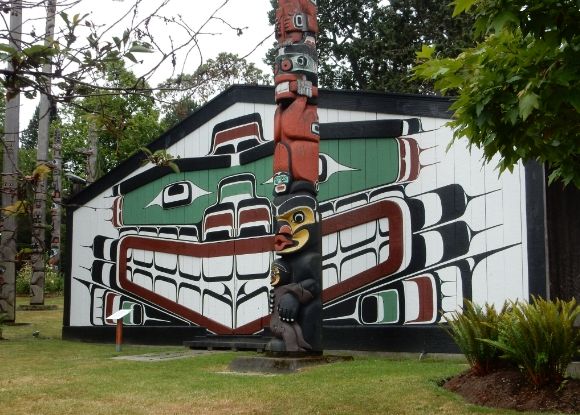 Shown above is a Northwest Coast longhouse in Victoria, British Columbia.
Shown above is a Northwest Coast longhouse in Victoria, British Columbia.
In the traditional Northwest Coast villages, the chief’s house was the largest and could accommodate the large crowds associated with entertaining, feasting, and potlatching. Many public gatherings and ceremonies would take place in the chief’s house. In his book Northwest Coast Indian Painting: House Fronts and Interior Screens, Edward Malin writes:
“The houses of the wealthier lineages tended to be located in the central part of the village, flanked on both sides by the others in descending order of wealth and status. The display of monumentally sized paintings or totem poles, both depicting the stellar crests associated with the house lineage, tended to be associated with the largest and hence wealthiest houses.”
The house was not only a physical structure, but also a reflection of social structure. Edward Malin writes:
“The size and power of each house was dependent on its acquired or inherited status in addition to the nature of the rights and privileges of its members.”
One of the features of some Northwest Coast houses is the interior screen. This is a large carved and painted panel. Art curator Steven Brown, in an article in American Indian Art, describes how a panel is made:
“First, the traditional procedure for creating a painted and relief-carved work in Northwest Coast style is to paint the design first, and then carve out the unpainted areas, some of which are afterward painted a blue-green color.”
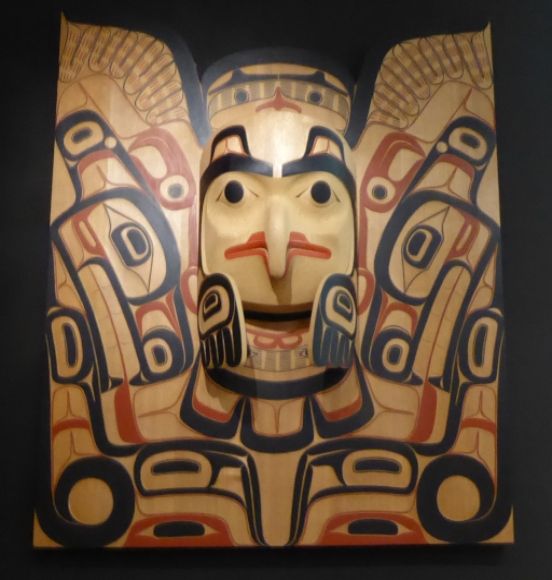 Shown above is a Tsimshian tribute panel made in 2012 by David Boxley, David Robert Boxley, and Zach Boxley using red cedar and pigment.
Shown above is a Tsimshian tribute panel made in 2012 by David Boxley, David Robert Boxley, and Zach Boxley using red cedar and pigment.
Edward Malin reports:
“House front paintings are plank wood exterior facades considerably larger than the front wall of the large cedar dwellings of the Northwest Coast Indians. Designs representing animal, bird, sea creature, or a combination of these and other-than-worldly beings are painted on the wood planks in bold configurations and are emblazoned with primary colors.”
Interior wood screens, were used to separate the household into different areas for the families living in the house. With regard to interior screens, Edward Malin writes:
“The wood surfaces facing the forward part of the house serve as a gigantic canvas for painting symbols of a complex nature laden with especially potent meaning for the occupants of the house.”
With regard to the distinctive Northwest Coast art, Edward Malin writes:
“Artists often felt compelled to represent an animal or bird by depicting not only its external body configuration but also, in a variety of designs, internal organs and skeletons that otherwise could not be seen with the naked eye. Body parts become unrecognizable as they are transformed into highly stylized representations.”
In his book Native Arts of North America, Christian Feest writes:
“The art is representational, but is is stylized and symbolic rather than naturalistic. Northwest Coast art is essentially decorative, although its function was the display of crests rightfully owned by certain kinship groups.”
Tlingit House Panels
Shown below are some nineteenth-century Tlingit house panels which are on display in the Portland Art Museum.
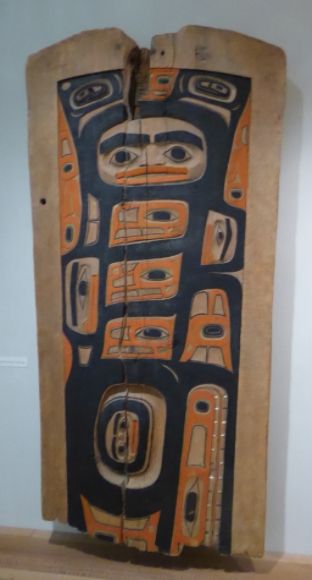
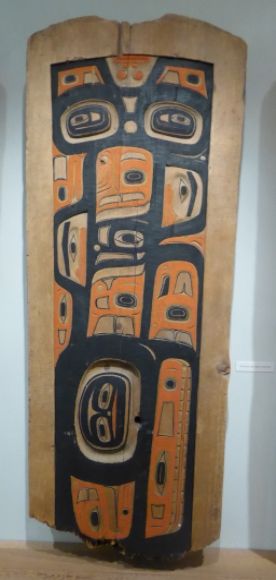
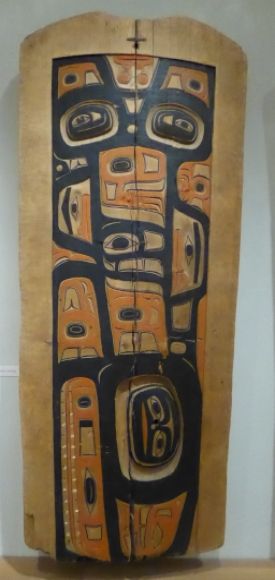
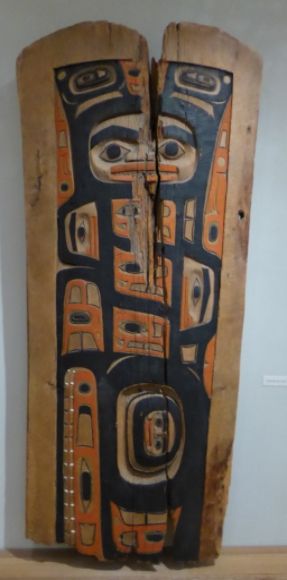
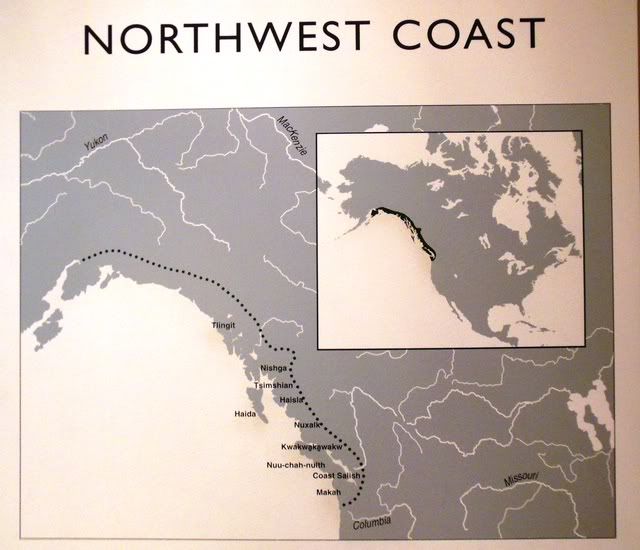
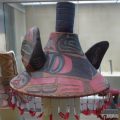
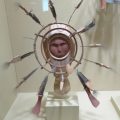
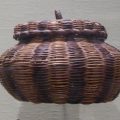
Leave a Reply